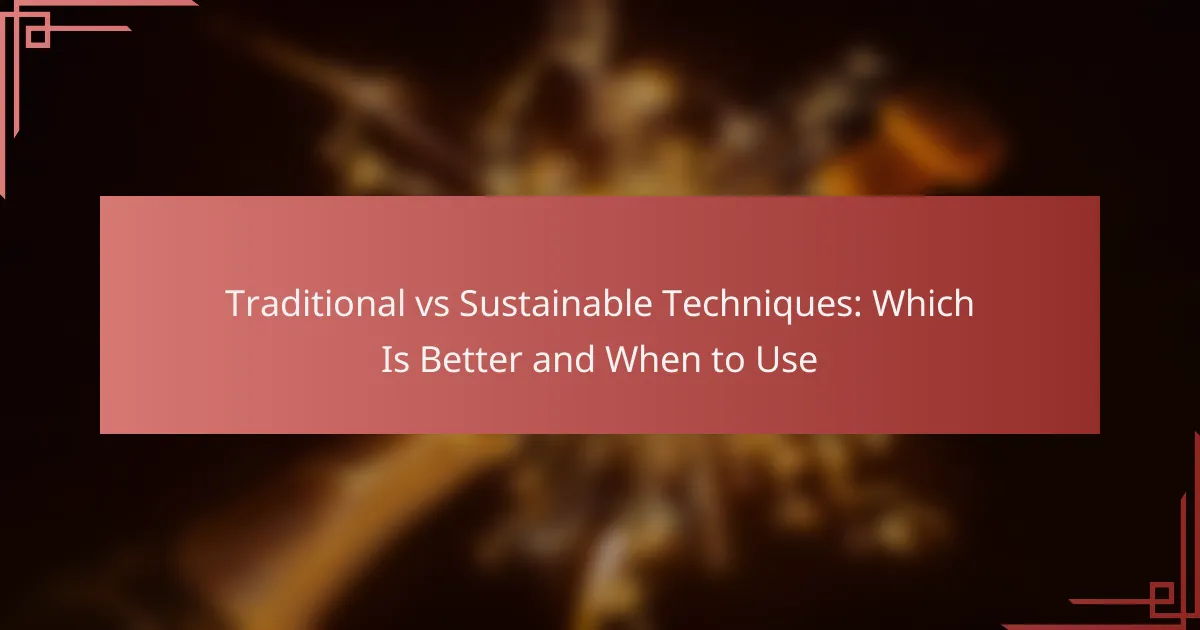Eco-friendly exhibition practices are essential for reducing environmental impact while promoting sustainability in the event industry. By focusing on sustainable materials, waste management, and energy-efficient techniques, exhibitors can create engaging displays that not only captivate audiences but also foster a sense of responsibility towards the planet. Utilizing eco-friendly materials such as bamboo, reclaimed wood, and recycled plastics further enhances these efforts, making exhibitions both innovative and environmentally conscious.

What are eco-friendly exhibition practices in the UK?
Eco-friendly exhibition practices in the UK focus on minimizing environmental impact through sustainable choices in materials, waste management, energy use, and display methods. These practices not only reduce carbon footprints but also promote awareness and responsibility among exhibitors and attendees.
Use of sustainable materials
Utilizing sustainable materials is crucial for eco-friendly exhibitions. This includes using products made from recycled, biodegradable, or sustainably sourced materials. For instance, exhibitors can opt for bamboo displays or recycled cardboard instead of traditional plastics.
When selecting materials, consider their lifecycle and potential for reuse. Engaging local suppliers who prioritize sustainability can also reduce transportation emissions and support the community.
Waste reduction strategies
Implementing waste reduction strategies is essential for minimizing the environmental impact of exhibitions. This can involve planning for recycling and composting stations at the event, ensuring that waste is sorted correctly by attendees.
Exhibitors should aim to reduce single-use items and consider alternatives such as digital brochures instead of printed materials. Setting clear goals for waste diversion can help track progress and encourage responsible practices among all participants.
Energy-efficient lighting
Energy-efficient lighting is a key component of eco-friendly exhibitions. Using LED lights can significantly lower energy consumption compared to traditional lighting options, providing bright illumination while reducing electricity costs.
Exhibitors should also consider natural lighting where possible, such as positioning displays near windows. Incorporating smart lighting systems that adjust based on occupancy can further enhance energy savings.
Digital displays over print
Choosing digital displays over print materials is an effective way to reduce waste and environmental impact. Digital screens can showcase multiple messages and updates without the need for physical printing, which saves resources and reduces waste.
Exhibitors should invest in high-quality digital displays that are energy-efficient and easy to update. This not only minimizes the need for printed materials but also allows for dynamic content that can engage attendees more effectively.

How can techniques improve sustainability in exhibitions?
Techniques can enhance sustainability in exhibitions by minimizing waste, reducing resource consumption, and promoting the use of eco-friendly materials. Implementing innovative strategies can lead to more efficient setups and a lower environmental impact.
Modular booth designs
Modular booth designs allow for flexibility and adaptability in exhibition spaces, making it easy to reconfigure setups for different events. These designs often use standardized components that can be reused across multiple exhibitions, reducing the need for new materials and minimizing waste.
Consider investing in modular systems that can be customized with various finishes and layouts. This approach not only saves resources but can also lower costs over time as the same components can be utilized repeatedly.
Reusable display elements
Using reusable display elements, such as banners, signage, and furniture, significantly cuts down on waste generated from single-use items. Opt for high-quality materials that can withstand multiple uses and are easy to transport.
When selecting reusable elements, look for options made from sustainable materials, such as recycled plastics or sustainably sourced wood. This not only supports eco-friendly practices but can also enhance your brand’s image as environmentally conscious.
Eco-friendly transportation methods
Eco-friendly transportation methods for exhibitions include using electric vehicles, carpooling, or public transport to move materials and staff. These methods help reduce carbon emissions associated with travel and logistics.
When planning transportation, consider local options that minimize distance and maximize efficiency. For instance, partnering with local suppliers can reduce the need for long-distance shipping, further lowering your exhibition’s environmental footprint.

What materials are considered eco-friendly for exhibitions?
Eco-friendly materials for exhibitions are those that minimize environmental impact, often through sustainable sourcing, recyclability, or biodegradability. Common examples include bamboo, reclaimed wood, recycled plastics, and biodegradable fabrics.
Bamboo and reclaimed wood
Bamboo and reclaimed wood are popular choices for eco-friendly exhibitions due to their sustainability. Bamboo grows rapidly and can be harvested without harming the plant, making it a renewable resource. Reclaimed wood, sourced from old buildings or furniture, reduces waste and gives a unique character to displays.
When using these materials, consider their treatment and finish, as some chemicals can negate their eco-friendliness. Look for natural finishes and verify the sourcing to ensure sustainability.
Recycled plastics
Recycled plastics are an effective way to reduce waste in exhibitions. These materials are repurposed from post-consumer products, minimizing the need for new plastic production. They can be used for signage, display stands, and other elements, offering durability and versatility.
When selecting recycled plastics, check for certifications that confirm the percentage of recycled content. Aim for products made from at least 30% recycled materials to ensure a significant environmental benefit.
Biodegradable fabrics
Biodegradable fabrics, such as organic cotton, hemp, and certain synthetics, break down naturally over time, reducing landfill impact. These materials are often used for banners, tablecloths, and other display items, providing an eco-friendly alternative to traditional textiles.
When choosing biodegradable fabrics, consider their lifecycle and the conditions required for proper decomposition. Look for certifications like GOTS (Global Organic Textile Standard) to ensure the fabric meets environmental and social criteria.

What are the benefits of eco-friendly exhibitions?
Eco-friendly exhibitions offer numerous advantages, including improved brand image, the ability to attract environmentally conscious visitors, and adherence to relevant regulations. By implementing sustainable practices, organizers can create a positive impact while enhancing their market position.
Enhanced brand reputation
Adopting eco-friendly practices in exhibitions can significantly boost a brand’s reputation. Companies that prioritize sustainability often gain trust and loyalty from consumers who value environmental responsibility.
For instance, using recyclable materials for booths and displays can showcase a commitment to sustainability, making the brand more appealing to potential clients and partners. Additionally, brands can leverage their eco-friendly initiatives in marketing campaigns to further enhance their image.
Attracting eco-conscious attendees
Eco-friendly exhibitions naturally draw attendees who prioritize sustainability. These individuals are often more engaged and willing to explore brands that align with their values.
To attract this demographic, organizers can promote green initiatives, such as waste reduction strategies and the use of renewable energy sources. Offering workshops on sustainable practices can also enhance attendee experience and increase participation.
Compliance with regulations
Many regions have implemented regulations that encourage or mandate sustainable practices in exhibitions. Complying with these regulations not only avoids potential fines but also positions the exhibition as a leader in sustainability.
For example, in the European Union, regulations may require the use of eco-friendly materials and waste management practices. Staying informed about local laws can help organizers ensure compliance while promoting their commitment to sustainability.

What criteria should be used to select eco-friendly materials?
To select eco-friendly materials, consider their environmental impact throughout their life cycle, including sourcing, production, use, and disposal. Prioritize materials that are renewable, recyclable, and have low toxicity to promote sustainability.
Life cycle assessment
Life cycle assessment (LCA) evaluates the environmental impacts of a material from raw material extraction to disposal. This process helps identify the most sustainable options by analyzing energy consumption, emissions, and resource depletion at each stage. When selecting materials, look for those with a lower overall environmental footprint based on LCA results.
For practical application, consider materials that are locally sourced to reduce transportation emissions and support local economies. Additionally, prioritize those that can be easily recycled or composted at the end of their life cycle to minimize waste.
Certifications and standards
Certifications and standards provide assurance that materials meet specific environmental criteria. Look for labels such as FSC (Forest Stewardship Council) for wood products, or Energy Star for energy-efficient appliances. These certifications indicate adherence to recognized sustainability practices.
When evaluating materials, check for compliance with local regulations and standards, such as the EU’s REACH (Registration, Evaluation, Authorisation and Restriction of Chemicals) for chemicals in products. This ensures that the materials are not only eco-friendly but also safe for consumers and the environment.

How do eco-friendly practices impact exhibition costs?
Eco-friendly practices can significantly influence exhibition costs, often leading to both savings and increased expenses. While sustainable materials and techniques may have higher upfront costs, they can reduce waste and operational expenses over time.
Exhibition Design Considerations
When designing an eco-friendly exhibition, consider using modular and reusable structures. These designs can lower costs in the long run by minimizing the need for new materials for each event. Additionally, incorporating natural lighting and energy-efficient technologies can reduce energy expenses.
Material Choices
Choosing sustainable materials is crucial for eco-friendly exhibitions. Options like recycled cardboard, bamboo, and biodegradable plastics can be more expensive initially but often lead to lower disposal costs. It’s essential to evaluate the lifecycle of materials to understand their long-term financial impact.
Transportation and Logistics
Transportation costs can rise when sourcing eco-friendly materials, especially if they are not locally available. However, consolidating shipments and using eco-friendly transport options can mitigate these costs. Consider partnering with local suppliers to reduce both carbon footprint and shipping expenses.
Waste Management Strategies
Implementing effective waste management strategies can help control costs associated with disposal. Establishing recycling and composting programs can minimize landfill fees and promote sustainability. Additionally, tracking waste can identify areas for improvement and potential savings.
Marketing and Branding Implications
Eco-friendly practices can enhance an exhibition’s brand image, attracting environmentally conscious attendees and sponsors. While marketing costs may increase initially, the long-term benefits of a strong sustainable brand can lead to higher attendance and revenue. Highlighting green initiatives in promotional materials can also create a competitive advantage.



